Table of Contents
Germany is a leader in offshore wind power among the European Union countries. By 2030, the nation plans to have 30 gigawatts (GW) of capacity installed across the North and Baltic Seas. This ambitious target translates to powering millions of homes with clean, renewable energy.
Germany has 1,560 offshore wind turbines operational, generating nearly 8.4 GW of electricity. This impressive figure is constantly rising, with additional offshore wind projects under construction slated to contribute another 500 MW to the grid. In the first half of 2023, German offshore wind farms produced 11.3 terawatt hours (million MWh) of electricity.
Germany's commitment to offshore wind extends beyond capacity. They're actively driving down costs through advancements in technology and operational practices. The German offshore wind industry employs a substantial workforce of 27,000 people, which is expected to grow alongside the booming sector. Let's explore the top 7 upcoming offshore wind farms in German waters.
Top 7 Upcoming New Offshore Wind Farms in Germany (Based on capacity)
| Project name | Capacity (MW) | Stage | Expected Operational Date | Project Owner |
| Nordlicht wind farm | 980 | Pre-Construction | 2027 | Vattenfall AB |
| He Dreiht wind farm | 945 | Announced | 2025 | EnBW |
| Gennaker wind farm | 927 | Pre-Construction | 2027 | WPD AG |
| Atlantis I wind farm | 584 | Pre-Construction | NA | Vattenfall AB |
| Hohe See wind farm | 497 | Operating | 2019 | EnBW |
| Delta Nordsee wind farm | 480 | Pre-construction | 2027 | RWE AG [51%]; Northland Power INC [49%] |
| Baltic Eagle wind farm | 476 | Pre-Construction | 2024 | Iberdrola Renovables Energia SA |
Nordlicht wind farm
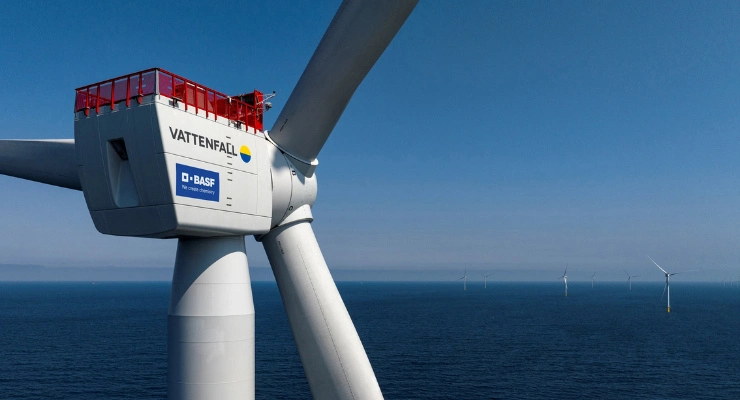
The Nordlicht I wind farm, located 85 kilometers north of Borkum in the North Sea, is a major renewable energy project led by Vattenfall AB. With an installed capacity of 980 MW, it will generate enough fossil-free electricity to power over one million German households annually.
Originally developed as "Global Tech II" and later "N-7.2," the site was re-auctioned in 2022 under the WindSeeG central tender regime. Vattenfall exercised its pre-emption right to match the zero-cent bid awarded to RWE, securing the project without government subsidies. The wind farm covers 52.63 square kilometers, with a water depth of 37-39 meters, and is expected to start producing power by the end of 2027.
Find Offshore Wind Project and Tender Leads in GermanyClaim Your Free Lead!
Key stakeholders in Nordlicht I include Vattenfall AB and BASF Construction Chemicals GmbH as owners and Tennet Offshore GmbH as the offshore transmission operator. The project's grid connection point is in Büttel, Schleswig-Holstein.
He Dreiht wind farm
The He Dreiht wind farm, EnBW's third offshore project in the North Sea, is set to make a significant impact when it becomes operational at the end of 2025. Located approximately 90 kilometers northwest of Borkum and 110 kilometers west of Helgoland, the farm will feature 64 Vestas V236-15 turbines, each with a 15 MW capacity, totaling an installed output of 960 MW.
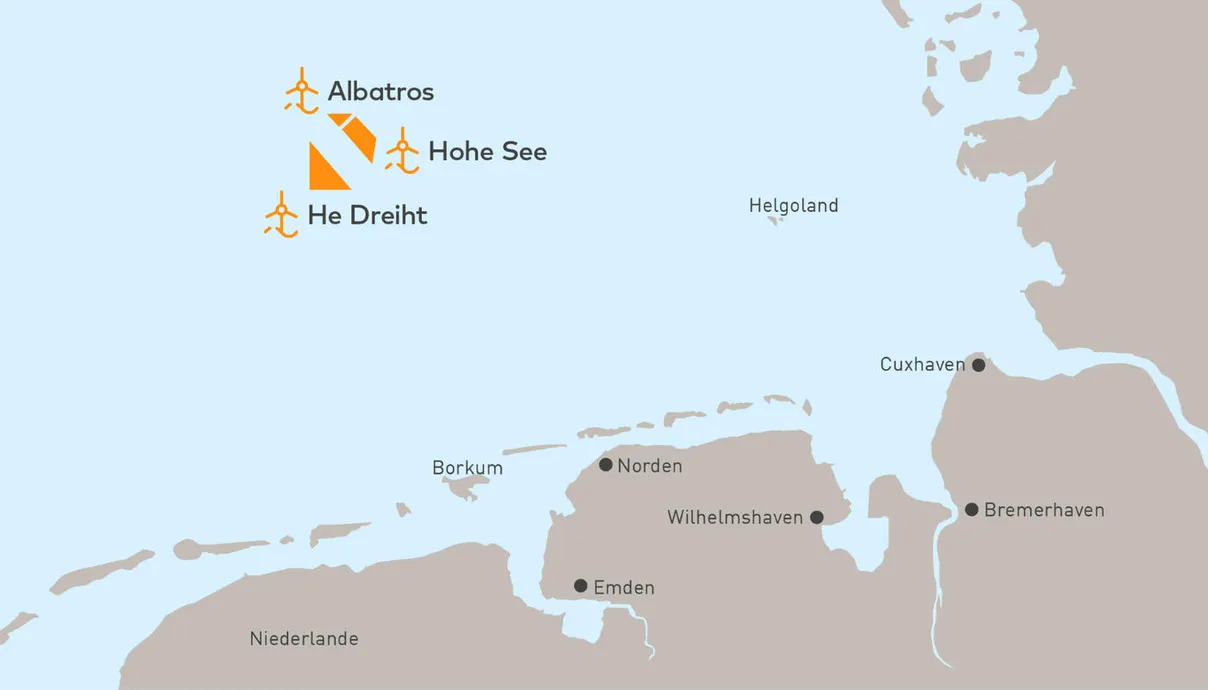
He Dreiht wind farm Location map
This substantial capacity will enable He Dreiht to supply renewable energy to 1.1 million households, doubling EnBW's offshore portfolio. Notably, He Dreiht is also one of the first offshore wind farms to be built without state funding, relying instead on power purchase agreements (PPAs) with major industrial customers like Fraport, Evonik, Salzgitter, and Deutsche Bahn to ensure a steady revenue stream.
Read: Top Five Upcoming Offshore Wind Farm Power Projects in Europe
EnBW has secured around EUR 2.4 Billion for the project, with EUR 600 Million euros in long-term financing from the European Investment Bank and a minority stake sale to a consortium including Allianz Capital Partners, AIP, and Norges Bank.
Gennaker wind farm
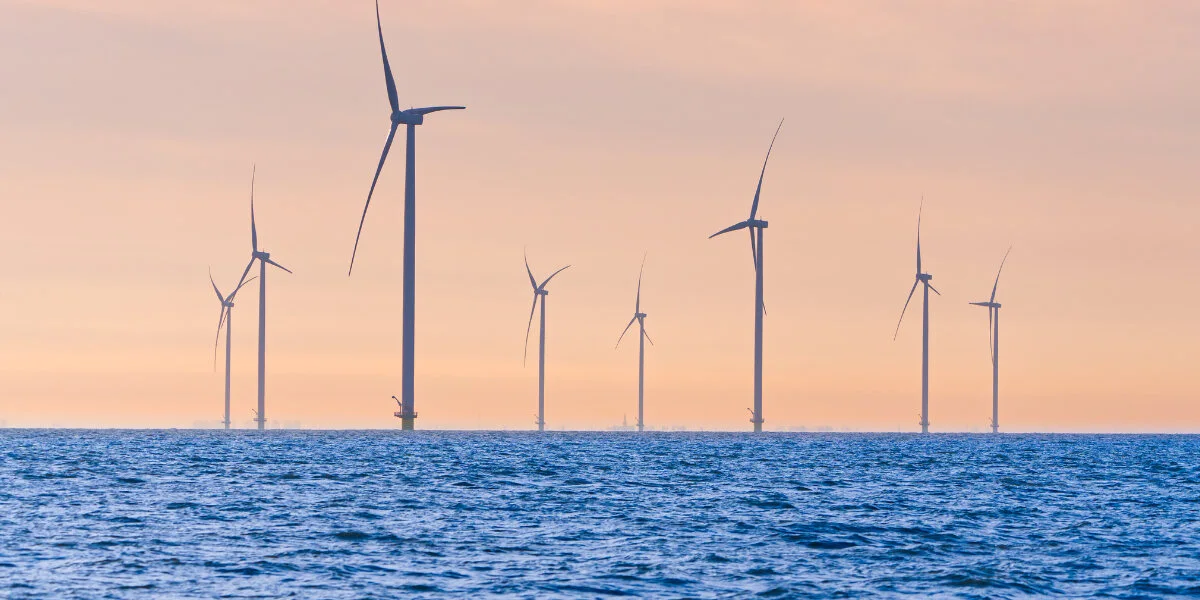
The Gennaker offshore wind farm is 15 kilometers off the Baltic Sea coast near the Darß peninsula. The offshore wind farm is set to become the most powerful offshore wind project in the Baltic Sea, with a total capacity of 927 MW.
Developer OWP Gennaker GmbH, under the ownership of Skyborn Renewables GmbH (formerly WPD), has initiated the project's realization by conditionally ordering 103 Siemens Gamesa offshore wind turbines, each with up to 9 MW capacity. The start of the primary soil investigation at each wind turbine location marks a significant milestone, and the tendering process for the remaining main components and installation vessels is underway.
Scheduled for the complete installation by the end of 2026 and commissioning by 2027, Gennaker will play a crucial role in supporting the German government's ambitious energy transition goals. By leveraging advanced offshore wind turbine technology and comprehensive planning, this project aims to significantly boost renewable energy production in the region, contributing to a sustainable and resilient energy future for Germany.
Atlantis I wind farm
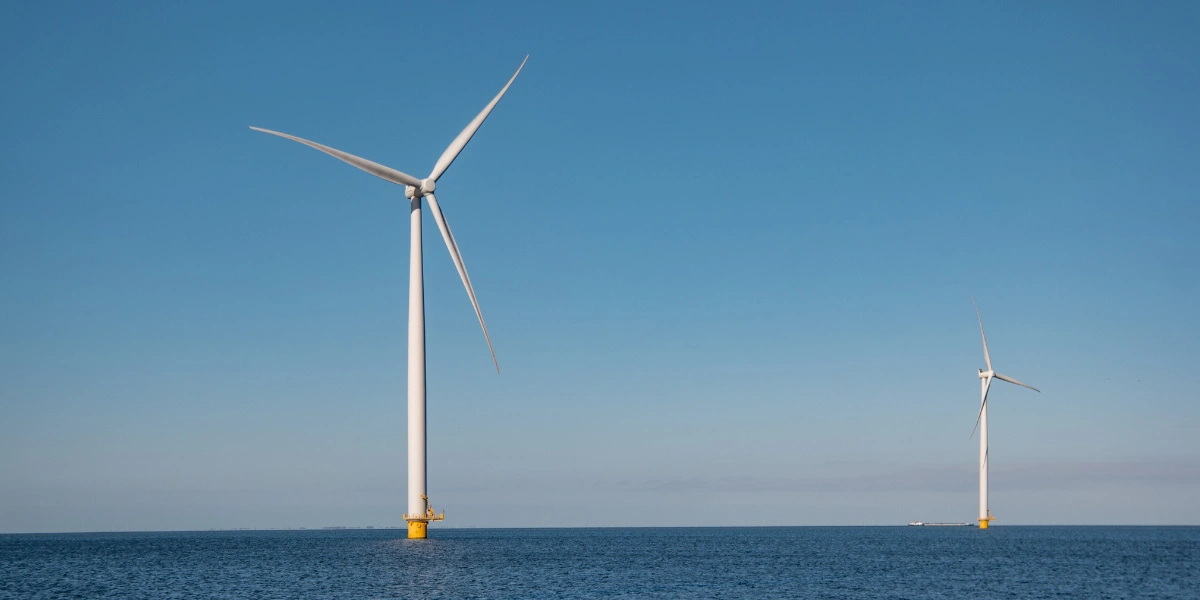
The Atlantis I offshore wind farm is a notable renewable energy project planned for the North Sea off the German coast. With a total capacity of 584 MW, the project is currently in the permitting stage and is being developed by BARD Engineering, PNE, and Vattenfall. Vattenfall, which now owns 100% of the project, acquired PNE WIND Atlantis I GmbH from PNE WIND AG, with PNE continuing to provide long-term development services.
Located 84 kilometers northwest of the island of Borkum, Atlantis I will consist of 73 multi-megawatt class offshore turbines, substantially contributing to Germany's renewable energy capacity.
Construction for Atlantis I is expected to commence in 2024, with the project slated to become operational by 2028. Once completed, it will significantly bolster Germany's offshore wind power portfolio, aligning with its ambitious energy transition goals.
EnBW Hohe See wind farm
The Hohe See wind farm, developed by EnBW, is situated in the North Sea. Located approximately 95 kilometers north of Borkum and 100 kilometers northwest of Helgoland, Hohe See comprises 71 SWT-7.0-154 turbines by Siemens Gamesa renewable energy. Each wind farm has a capacity of 7.35 MW, totaling 521.85 MW of installed capacity.
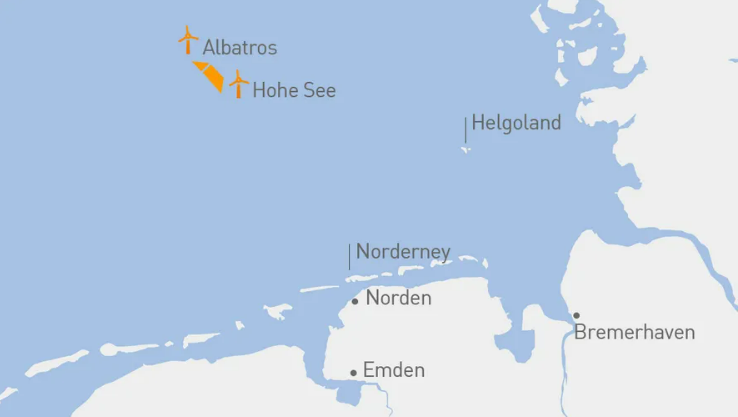
EnBW Hohe See location map
Together with the adjacent Albatros wind farm, this joint project has a combined capacity of 639.45 MW, generating around 2.5 billion kilowatt hours of electricity annually, enough to power approximately 710,000 households. Since its grid connection in October 2019, Hohe See has contributed significantly to the region's renewable energy supply and reduction efforts, saving around 1.9 million tonnes of carbon dioxide annually.
EnBW's investment in Hohe See amounted to around 1.8 billion euros. To finance the project, EnBW partnered with the Canadian energy infrastructure company Enbridge Inc., which acquired a 49.9 percent stake in the wind farm. EnBW has a strong presence in the Baltic Sea with its already operational EnBW Baltic 2 wind farm.
Delta Nordsee wind farm
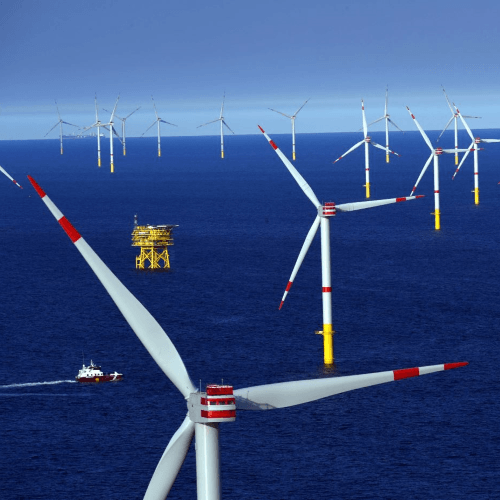
The Delta Nordsee wind farm, also known as Nordsee Cluster B - N-3.6 or North Sea Cluster Phase 2, is an ambitious offshore wind project in the early planning stages in Lower Saxony, Germany. This project is part of a broader initiative, Nordseecluster B GmbH, which encompasses wind farm sites in the eastern part of the German North Sea. Delta Nordsee is expected to have a nameplate capacity of 480 MW and is scheduled for commissioning in 2027. The project is being developed by RWE Renewables, which holds a 51% stake, and Northland Power INC, keeping the remaining 49%.
Delta Nordsee will benefit from its proximity to other offshore projects located within the German Bight's Exclusive Economic Zone (EEZ), allowing for economies of scale and efficient development. The wind farm will feature offshore hard mount technology and will be operated by Amprion GmbH for offshore transmission.
Baltic Eagle wind farm
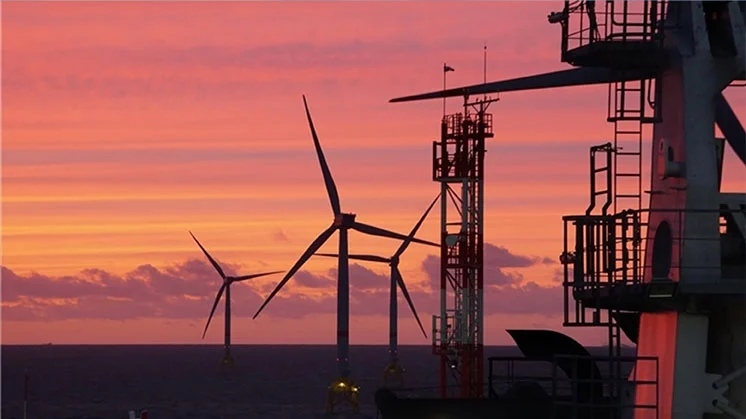
Baltic Eagle, the Iberdrola Group's second major offshore wind project in the Baltic Sea, is located 30 kilometers northeast of Rügen Island off the coast of Pomerania. This 476 MW wind farm will supply green electricity to approximately 475,000 households. Construction began in 2022, with full commissioning anticipated by 2024.
The project will feature 50 MHI Vestas Offshore Wind turbines, each with a capacity of 9.53 MW, designed to maximize energy production and reduce CO2 emissions by 800,000 tonnes annually.
A strategic partnership with Masdar, valued at around EUR 1.6 billion, underpins Baltic Eagle's development. The project involves significant collaboration across the supply chain, with components manufactured by firms like Asturian Windar and German EEW SPC. The installation process is supported by the jack-up vessel Blue Tern and managed by Fred. Olsen Windcarrier ensures precision in the challenging Baltic Sea conditions.
Read: Top 7 Floating Offshore Wind Projects in United Kingdom (UK)
Van Oord is responsible for transporting and installing monopiles and interconnection cables using advanced vessels like Svanen and Nexus. The offshore substation, installed by Heerema and operated by 50Hertz, will connect the wind farm to the Lubmin onshore station via high-voltage subsea cables, ensuring seamless integration into the power grid.
Current and Future Outlook of German Offshore Wind
By the end of 2023, offshore wind Deutschland had 1,566 offshore wind turbines with a total capacity of 8.5 GW. During the year, 27 new turbines began feeding into the grid, adding 257 MW of capacity, and modifications were made to 222 existing turbines, enhancing their capacity by 72 MW. The expansion aligns with Germany's transitional offshore wind energy projects from 2017/2018 tenders, which are expected to be fully operational by 2025.
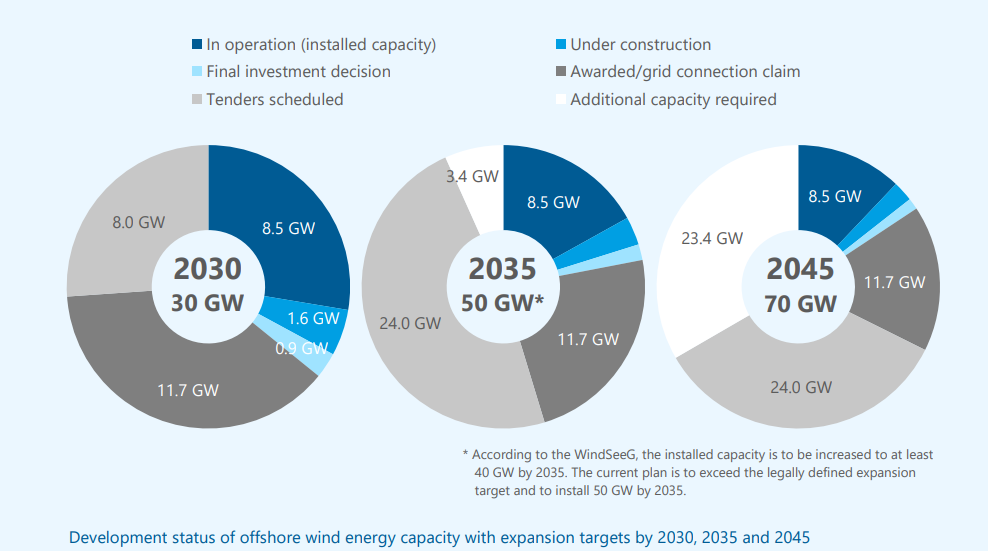
Source: wind-energie.de
Germany's offshore wind energy sector is set to meet ambitious growth targets, as outlined in the German Offshore Wind Energy Act. The installed capacity aims to reach 30 GW by 2030, 50 GW by 2035, and 70 GW by 2045. The Federal Maritime and Hydrographic Agency's Site Development Plan is central to these goals, designating new areas for development. The 2023 plan outlines the addition of 8 GW by 2030, with further sites planned to achieve 50 GW by 2035 and the additional regions necessary for the 70 GW target by 2045.
Germany's commitment to offshore wind extends beyond just capacity. They've actively driven down costs through advancements in technology and operational practices. This progress is further supported by the Renewable Energy Sources Act (EEG), which has provided a stable regulatory framework and financial incentives for renewable energy projects, including offshore wind farms.
Explore Projects and Tenders in Germany
Claim Your FREE Demo Today! Claim Your Free Lead!
Future offshore projects include significant installations like Baltic Eagle and Gode Wind 3, scheduled for 2024, and larger projects like Borkum Riffgrund 3 and EnBW He Dreiht by 2025. Recent tenders awarded sites for substantial future capacity, including 7 GW in non-centrally pre-investigated sites and 1.8 GW in centrally pre-investigated sites. These projects will use advanced turbine technologies with increasing capacities, hub heights, and rotor diameters, reflecting the ongoing evolution and expansion of Germany's offshore wind energy infrastructure.
Conclusion
Germany is a leader in renewable energy, focusing strongly on offshore and onshore wind farms. These renewable energy sources are crucial in the country's transition to a clean and sustainable energy future. Germany's leadership in the offshore wind sector is evident through its ambitious targets and extensive infrastructure. By 2030, the nation aims to reach 30 GW of capacity, contributing to its renewable energy goals.
With over 1,560 turbines already generating 8.4 GW and numerous projects underway, Germany's offshore wind farms power millions of homes with green energy. The top upcoming wind farms, including Nordlicht, He Dreiht, and Gennaker, showcase the innovative and large-scale developments driving this growth. As the sector evolves with advanced technologies and strategic investments, Germany's offshore wind energy promises a sustainable and resilient future.
Connect with decision-makers of floating offshore wind projects in Germany for business opportunities.
Subscribe to our German Floating Offshore Wind Farm Project and Tender Database to get access to reliable and high-quality insights on upcoming, in-progress, and completed floating offshore plant projects across the world or in your desired geographical location.
Our user-friendly platform provides essential details, timely updates, key stakeholder contact information, and business opportunities tailored for engineering companies, industry professionals, investors, and government agencies.
Start a free demo to take your business to the next level!







Leave a Comment
We love hearing from our readers and value your feedback. If you have any questions or comments about our content, feel free to leave a comment below.
We read every comment and do our best to respond to them all.